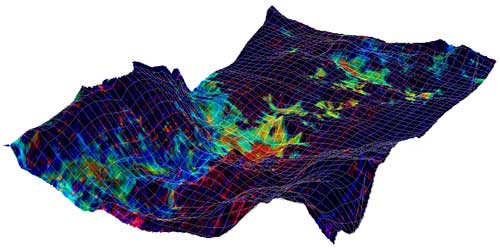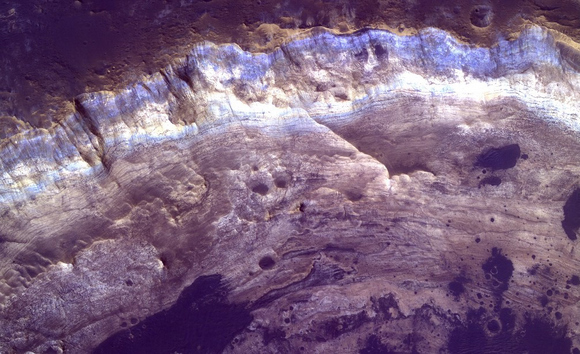[/caption]
Images and data from the Mars Reconnaissance Orbiter (MRO) have revealed layers of clay-rich rock that suggests abundant water was once present on Mars. Scientists from the SETI Institute, the Jet Propulsion Laboratory and several universities have been studying data focused on the Mawrth Vallis area on Mars’ northern highland region. This is a heavily cratered, ancient area of the Red Planet whose surface geology resembles a dried-up, river valley through which water may have flowed. While their findings don’t provide evidence for life, it does suggest widespread and long-term liquid water in Mars’ past.
The researchers used the Compact Reconnaissance Imaging Spectrometer for Mars (CRISM) aboard MRO to examine infrared light reflected from clays situated in the many-kilometer wide channel of Mawrth Vallis.
The infrared spectra from CRISM show an extensive swath of phyllosilicate-bearing material. This is a type of iron and magnesium-rich clay that forms in liquid water, and can be found on Earth in oceans and river beds. It is familiar to anyone who’s nearly broken a shovel while trying to plant a tree. There is also evidence in the spectra for hydrated silica, which in its pure, clean form is known as opal.
The researchers combined their data on the composition of soils in this region with topographic information collected by MOLA, the Mars Orbiter Laser Altimeter, on board the Mars Global Surveyor spacecraft. They found layered aluminum clays lying on top of hydrated silica and iron/magnesium clays. These clays were likely formed when water came in contact with basalt – which is the dominant component of the Martian highlands, and probably was produced from volcanic ash, which once blanketed the planet.

“We were surprised by the variety of clay minerals in this region,†says Janice Bishop of the SETI Institute. “But what’s interesting is that we find the same ordering of the clay materials everywhere in Mawrth Vallis. It’s like a layer-cake of clays, one on top of another. All these layers are topped with a ‘frosting’ of lava and dust. We can see the clay layers where an impact crater has carved a hole through the surface or where erosion has exposed them.â€
Since phyllosilicates have been found in a number of outcrops on Mars in CRISM images, these new data suggest that whatever mechanism formed clays at Mawrth Vallis has probably operated over much greater areas of the Red Planet. Alteration by liquid water may have been widespread on early Mars.
Bishop is careful to note that this work is part of the long-term effort to establish just how widespread, and for what period of time, liquid water may have existed on Mars.
“This is not evidence for life,†she notes. “But it does suggest the long-term and common presence of liquid water – and concomitant active chemistry – on the Red Planet in the distant past.â€
News Source: SETI Institute


Great picture, nice straight forward information. Of course the “this is no evidence of life” comment was cautionary inserted. But it is a step forward, especially if NASA continues a policy, clear, well defined photos for everything they take picture of.
Kudos for this.
yes Great pictures and without this sort of info people like me would still be looking up thinking whats that red planet look like if your on it one thing i do know you have no chance of drowning if your go ther
WATER, THOUGH, NOT SUPRISING, FOUND ON MARS MAY NEED A COMPLEX HARVESTING METHOD. I HAVE A GRAVE CONCERN OF ALIEN BACTERIA, FUNGUS AND OTHER MICRO LIFE THAT MAY FOREVER AND NEGATIVELY IMPACT OUR COLONIZATION. I HOPE ANY CRAFTS OR SUBJECTS RETURNING TO EARTH ARE THOROUGHLY SCRUBBED AND SCANNED FOR ALIEN BUGS. I GUESS THEY’VE ALREADY THOUGHT OF THIS! WOW
Please refrain from using all caps – thanks.
I’m not a biologist, but AFAIU other biospheres should pose no problems for each other in biology. Alien organisms aren’t adapted and as spectacularly unfit compared to the competition will likely be driven to extinction by everyday evolutionary mechanisms.
There are no alien bugs…because we have yet to discover alien life form…
Maybe it’s time to define a list of reserves and add this one, if we ever want to be able to determine how life may have started in the Solar System.
If such an environment gets wasted by pollution from earth this could be a lot more difficult for future generations.